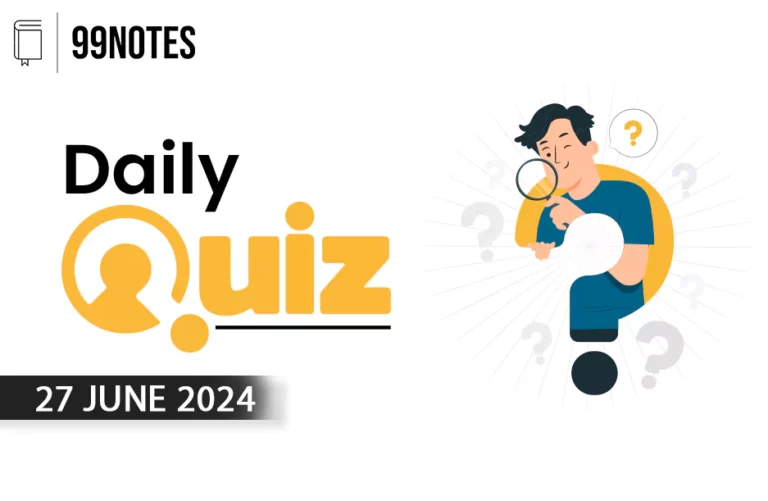28 June 2024 : Daily Current Affairs
1. India and U.S. in talks for Stryker infantry vehicles
(Source – The Hindu, International Edition – Page No. – 4)
| Topic: GS2 – International relations – Bilateral Relations |
| Context |
|
Analysis of the news:
- India and the U.S. are in early discussions about co-producing Stryker infantry vehicles and Javelin anti-tank guided missiles (ATGM).
- U.S. Deputy Secretary of State Kurt M. Campbell mentioned the potential for local manufacture of several hundred Stryker variants with customizations for the Indian Army.
- Several Indian defence officials are cautious about the Stryker deal, citing similar vehicles developed by Indian companies.
- The U.S. Army plans to demonstrate the Stryker’s capabilities to the Indian Army soon.
- India and the U.S. are also exploring co-production and collaboration in R&D for Javelin and Stryker.
- The discussions are part of the broader India-U.S. iCET (initiative on Critical and Emerging Technology) framework.
- The U.S. has previously demonstrated Stryker and Javelin to the Indian Army during bilateral exercises.
- The MQ-9B unmanned aerial vehicles deal is also progressing, with the letter of offer and acceptance sent to India in early March.
- General Atomics is negotiating the sale details with India’s Ministry of Defence, awaiting final approval.
- The GE-414 jet engines licence manufacture deal by Hindustan Aeronautics Ltd. (HAL) for the Light Combat Aircraft (LCA)-Mk1A is also in advanced stages, with expected Cabinet Committee on Security (CCS) approval in the coming months.
| Stryker Infantry Vehicles And Javelin Anti-Tank Missiles: |
|
Stryker Infantry Vehicles:
|
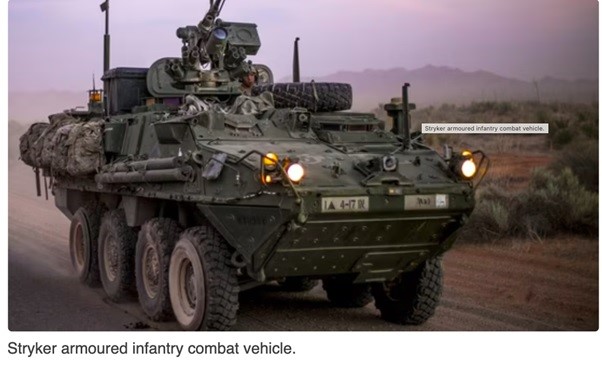
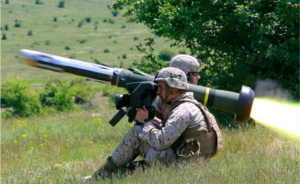 Javelin Anti-Tank Missile
Javelin Anti-Tank Missile
| PYQ: What is the significance of Indo-US defence deals over Indo-Russian defence deals? Discuss with reference to stability in the Indo-Pacific region. (250 words/15m) (UPSC CSE (M) GS-2 2020) |
| Practice Question: Discuss the strategic and operational advantages for India in importing Stryker infantry vehicles and Javelin anti-tank missiles. How can these acquisitions enhance India’s defence capabilities? (150 Words /10 marks) |
2. Healthcare providers need to pay greater attention to informed consent
(Source – The Hindu, International Edition – Page No. – 7)
| Topic: GS2 – Social Justice – Health |
| Context |
|
More About Informed Consent:
- Definition: Informed consent is the process where a patient is provided with all relevant information about their condition, treatment options, procedures, and potential complications to make an informed decision.
Key Elements:
- Information Disclosure: Patients should receive comprehensive details about their diagnosis, proposed treatments, alternatives, risks, and benefits.
- Comprehension: Information must be conveyed in a language and manner that the patient understands.
- Voluntariness: The decision to consent must be made without coercion or undue influence.
- Documentation: The consent form should be filled out completely and signed only after the patient has understood all the information.
Legal and Ethical Importance:
- Legal Protection: A properly documented informed consent form can protect healthcare providers in cases of medical litigation.
- Patient Rights: It ensures that patients are aware of their rights and are actively involved in their healthcare decisions.
Best Practices:
- Doctor’s Responsibility: The healthcare provider performing the procedure should obtain the consent.
- Language Accessibility: Consent forms should be available in the patient’s native language to ensure understanding.
- Detailed Explanation: Providers should explain all aspects of the procedure, potential risks, and alternatives in person.
Challenges and Solutions:
- Overcoming Language Barriers: Use multilingual forms or interpreters.
- Enhancing Understanding: Employ visual aids like images or videos to explain procedures.
- Patient Awareness: Educate patients about their right to informed consent and encourage them to ask questions.
Impact on Healthcare:
- Patient Satisfaction: Better informed patients are generally more satisfied with their care.
- Improved Outcomes: Clear understanding and communication can lead to better health outcomes and patient compliance.
| Practice Question: Discuss the challenges and implications of inadequate informed consent processes in Indian healthcare. (150 Words /10 marks) |
3. Bombay High Court Upholds Hijab Ban in College, Citing “Larger Academic Interest”
(Source: Indian Express; Section: Explained; Page: 09)
| Topic: GS2 – Polity |
| Context: |
|
Contention on the Dress Code:
- The controversy began in August last year when several junior college girls wearing hijabs were denied entry for non-compliance with the prescribed uniform.
- In response, the Chembur college issued a new dress code in May, to be implemented in the academic year starting June.
- The code prohibited burqas, niqabs, hijabs, and any religious identifiers like badges, caps, or stoles.
- It mandated half-and full-sleeved shirts with trousers for boys and “any Indian/western non-revealing dress” for girls.
- Nine women students challenged this dress code, deeming it “arbitrary and discriminatory.”
Bombay High Court Judgment:
- A division Bench comprising Justices Atul S Chandurkar and Rajesh S Patil upheld the dress code, emphasizing its role in the “larger academic interest.”
- The court found no violation of Article 19(1)(a) or Article 25 of the Constitution. The Bench stated that the dress code aimed to ensure students’ attire did not reveal their religion, thereby allowing them to focus on education.
- The judges rejected the claim that wearing a hijab or niqab is an essential religious practice, noting the lack of substantial evidence beyond the English translations of Kanz-ul-Iman and Saman Abu Dawud.
- The court further stated that the dress code applied equally to all students, regardless of caste, creed, religion, or language, and thus did not violate UGC guidelines.
Order of the Karnataka High Court:
- Justice Chandurkar, who authored the judgment, expressed complete agreement with the Karnataka High Court’s 2022 ruling.
- The Karnataka HC had maintained that the prescription of a dress code aimed to achieve uniformity among students, thus promoting discipline and avoiding the disclosure of one’s religion. This measure was deemed essential for serving constitutional secularism.
- Although the Karnataka HC’s verdict is currently under challenge at the Supreme Court, with a split verdict from a two-judge Bench in October 2022, the case has been referred to a larger Bench.
- The Bombay HC verdict is also likely to be contested before the Supreme Court.
Implications and Future Prospects:
- The Bombay High Court’s decision to uphold the college’s dress code underscores the judiciary’s support for institutional regulations intended to maintain uniformity and discipline in educational settings.
- The court’s alignment with the Karnataka High Court’s judgment highlights a judicial trend favoring secularism and uniformity in academic institutions.
- As the case progresses to the Supreme Court, it will be crucial to observe how the larger Bench addresses the balance between individual religious rights and institutional regulations aimed at promoting uniformity and secularism.
- The outcome will have significant implications for dress code policies in educational institutions across India.
| How is Religious Freedom Protected under the Constitution? |
|
| Practice Question: Analyze the implications of the Bombay High Court’s decision to uphold the dress code banning the hijab in a Chembur college. Discuss how this judgment aligns with previous court rulings on similar issues and the potential impact on individual religious rights and institutional regulations in India. (250 words/15 m) |
4. Buffer Stocks Crucial in Curbing Food Inflation Amid Climate Challenges, Calls for Comprehensive Policy Strengthen
(Source: Indian Express; Section: Explained; Page: 09)
| Topic: GS3 – Agriculture |
| Context: |
|
Analysis of News:
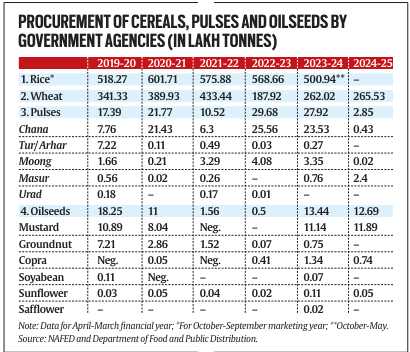
Role of Buffer Stocks:
- Buffer stocks played a crucial role in mitigating the inflation rates. For instance, in the fiscal year 2022-23, the Food Corporation of India (FCI) released 34.82 lakh tonnes (lt) of wheat from its stocks to the open market.
- This amount increased to a record 100.88 lt in the following fiscal year. These sales included flour processed and sold under the ‘Bharat Atta’ brand at a maximum retail price of Rs 27.5/kg.
- This intervention helped bring down retail inflation in cereals and wheat from their peaks of 16.73% and 25.37% respectively in February 2023 to 8.69% and 6.53% in May 2024.
Buffer Stock’s Role in Chana Prices:
Procurement and Sales
- The National Agricultural Cooperative Marketing Federation of India (NAFED) played a pivotal role in stabilizing chana prices.
- During the marketing seasons of 2022 and 2023, NAFED procured 25.56 lt and 23.53 lt of chana at the government’s declared minimum support price (MSP), which was above the prevailing market rates at the time.
- These stocks proved invaluable in curbing inflation in pulses amid a poor crop year and an El Niño-induced patchy monsoon.
Impact of NAFED’s Interventions
- Since July 2023, NAFED has sold 14.06 lt of chana through open market e-auctions, 16.09 lt as ‘Bharat Dal’ at Rs 60/kg, and 2.91 lt as discounted supplies to state governments.
- This extensive selling brought down their stocks significantly but helped stabilize market prices and prevented an even higher inflation rate for pulses.
About NAFED:
- NAFED is an apex organization of marketing cooperatives for agricultural produce in India.
- It was founded on 2 October 1958 to promote the trade of agricultural produce and forest resources across the nation.
- It is registered under the Multi State Co-operative Societies Act.
- With its headquarters in New Delhi, NAFED has four regional offices in Delhi, Mumbai, Chennai and Kolkata, apart from 28 zonal offices in capitals of states and important cities.
CPI and Food Inflation:
- Overall CPI inflation stood at 4.75% year-on-year in May, the lowest in 12 months. However, retail food inflation remained high at 8.69%.
- The volatility and unpredictability of food prices, exacerbated by climate change, have made it challenging for the Reserve Bank of India (RBI) to consider monetary easing or interest rate cuts.
Challenges and Solutions
- The government often resorts to measures like restricting exports or imposing stock limits on traders and processors to control prices.
- However, a more sustainable solution might involve creating a buffer stock of all essential food items.
- Procuring these items during surplus years and releasing them during shortages could help stabilize market prices.
Potential Buffer Stock Expansion
- Currently, government agencies primarily procure rice, wheat, and a few pulses and oilseeds.
- There is potential to expand procurement to include staple vegetables and skimmed milk powder (SMP).
- For instance, dehydrated or processed forms of vegetables like onion, potato, and tomato could be stored and sold to institutional buyers, ensuring households do not compete to drive up prices during shortages.
Fiscal Implications and Benefits
- The fiscal cost of maintaining these buffer stocks might not be substantial since these commodities are not intended to be given out for free but sold at near-market prices during inflationary periods.
- This strategy could help curb excessive volatility in food prices, similar to how the RBI manages foreign exchange reserves to stabilize the currency market.
- Given the increasing climate-driven price volatility, establishing a robust food buffer policy appears increasingly necessary to benefit both consumers and producers.
| PYQ: What are the reformative steps taken by the government to make food grain distribution system more effective? (250 words/15m) (UPSC CSE (M) GS-3 2019) |
| Practice Question: Discuss the role and effectiveness of buffer stocks in mitigating food inflation in India, considering recent trends and challenges. How can a comprehensive buffer stock policy contribute to stabilizing food prices amidst climate change impacts? Illustrate with relevant examples and suggest potential improvements. (250 words/15 m) |
5. Scientists find first evidence that butterflies crossed the Atlantic Ocean
(Source: Indian Express; Section: The World)
| Topic: GS3 – Environment |
| Context: |
|
Analysis of News:
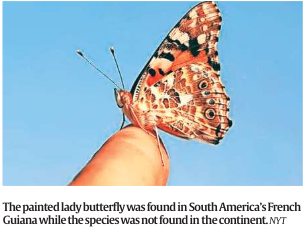
Investigating the Long-Distance Flight:
- The painted lady is known for its impressive long-distance migrations, such as the annual trek across the Sahara from Europe to sub-Saharan Africa, covering up to 9,000 miles.
- This observation led Talavera to question whether these butterflies had made the 2,600-mile journey across the Atlantic Ocean without any stops.
- However, tracking the movements of insects is challenging due to the limitations of current tracking technologies like radio devices, which are too large for small insects, and radar, which is restricted to specific locations.
Innovative Tracking Methods:
- In 2018, Talavera developed a novel method to track insect movements using genetic sequencing to analyze pollen DNA.
- Pollen grains, which stick to butterflies when they feed on nectar, could be sequenced to determine their plant origins.
- This information could then be used to map the butterflies’ travel routes.
- Talavera and his team applied this technique to the stranded butterflies, finding that the pollen on them matched flowering shrubs in West African countries, suggesting the butterflies had indeed crossed the Atlantic.
Genetic Evidence and Scientific Validation:
- To further substantiate their findings, Talavera’s team sequenced the butterflies’ genomes to trace their lineage, revealing European-African roots.
- Additionally, they used isotope tracing to confirm the butterflies’ origins in Western Europe, North Africa, and West Africa.
- This comprehensive analysis provided strong evidence that the painted lady butterflies had undertaken the first recorded transoceanic journey by an insect.
Implications of the Findings:
- The study suggests that these butterflies were likely diverted from their usual route through Africa by strong winds and continued flying until they reached the shore.
- This discovery highlights the extraordinary resilience and navigational capabilities of painted lady butterflies.
- Insect migrations represent the largest movement of biomass globally, with an estimated 3.5 trillion insects migrating annually over southern England alone.
- The ability of insects to transport pollen, fungi, and plant diseases across vast distances underscores their significant ecological impact.
- The documented oceanic migration of painted ladies offers scientists a better understanding of insect journeys and demonstrates the enduring resilience of these delicate creatures, showcasing how much more there is to learn about insect migration and behavior.
| Practice Question: Discuss how painted lady butterflies made a transoceanic journey from Africa to South America, and what are the implications of this discovery for understanding insect migration? (250 words/15 m) |
Prelims Facts
1. Antelope-like mammal from Bhutan recorded at lowest elevation in western Assam
(Source – The Hindu, International Edition – Page No. – 6)
| Context |
|
Analysis of the news:
- The mainland serow, a goat-antelope hybrid mammal, has been recorded at its lowest elevation outside its natural habitat in Bhutan, in Assam, India.
- Scientists documented a lone mainland serow (Capricornis sumatraensis thar) at 96 metres above mean sea level in Raimona National Park, western Assam.
- This marks the first time the elusive animal has been found within 1 km of human habitation.
- The discovery was detailed in a scientific paper published in the Journal of Threatened Taxa.
- The International Union for Conservation of Nature (IUCN) notes that mainland serows typically inhabit elevations of 200 to 3,000 meters.
- The serow’s habitat spans into Bhutan’s Phibsoo Wildlife Sanctuary and Royal Manas National Park.
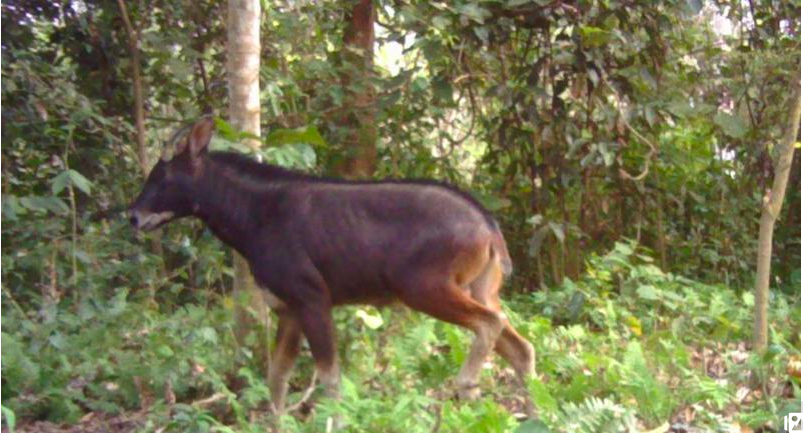
2. Multiple-warhead missile test success, says North Korea
(Source – The Hindu, International Edition – Page No. – 4)
| Context |
|
Analysis of the news:
- North Korea conducted a successful test of its multiple-warhead missile capability, as reported by state media.
- The test involved the separation and guidance control of individual mobile warheads to designated targets.
- Pyongyang aims to achieve Multiple Independently targetable Reentry Vehicle(MIRV) capability, allowing multiple warheads on a single ballistic missile.
- In response to perceived provocations from South Korea, North Korea has intensified weapons testing and sent balloons filled with trash southwards.
- South Korea initially identified the test as a hypersonic missile launch but reported it ended in mid-air explosion due to possible combustion issues.
| Multiple Independently targetable Reentry Vehicle(MIRV) Technology: |
|
3. Bolivian President Thwarts Coup Attempt as Military Withdraws from Palace
(Source: Indian Express; Section: The World)
| Context: |
|
Analysis of News:
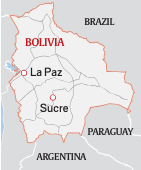
About Bolivia
- Bolivia, officially the Plurinational State of Bolivia, is a landlocked country located in western-central South America.
- It is named after independence fighter Simon Bolivar.
- The country is located in the rugged Andes Mountain, with a highland plateau and lowland plains in the Amazon basin.
- One-third of the country is within the Andean mountain range.
- Bordering Countries: It borders the countries of Argentina, Brazil, Chile, Paraguay, and Peru.
- Capital: The constitutional capital is Sucre, while the seat of government and executive capital is La Paz.
- Bolivia shares control of Lago Titicaca, the world’s highest lake navigable to large vessels, at 12,500 feet above sea level.
- History:
- During the 15th and 16th centuries, an ancient civilization called the Inca reigned over the region.
- In 1538, Spanish conquistadors (or ‘conquerors’) arrived from Europe and gained control of the territory.
- It broke away from Spanish rule in 1825.
- Much of its subsequent history has consisted of a series of coups and countercoups, with the last coup occurring in 1978.
- Democratic civilian rule was established in 1982.
- Currency: Bolivian boliviano
- Official Language: It has 37 official languages, including Spanish.
- Bolivia has a mixed economic system that includes a variety of private freedoms combined with centralized economic planning and government regulation.
4. Only 2 Out of 120 Indian District Hospitals Meet Health Standards, Reveals Government Assessment
(Source: Indian Express; Section: Express Network; Page: 07)
| Context: |
|
Analysis of News:
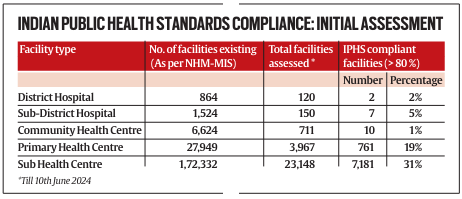
About Indian Public Health Standards
- IPHS are a set of uniform standards envisaged to improve the quality of health care delivery in the country.
- The IPHS documents have been revised keeping in view the changing protocols of the existing programmes and introduction of new programmes especially for Non-Communicable Diseases.
- Flexibility is allowed to suit the diverse needs of the States and regions.
- The IPHS guidelines act as the main driver for continuous improvement in quality and serve as the benchmark for assessing the functional status of health facilities.
- States and UTs adopt these IPHS guidelines for strengthening the Public Health Care Institutions.
Findings from the Initial Assessment
- The initial assessment covered 120 of the 864 district hospitals in the country, revealing that only two hospitals—Karimnagar and Peddapalli in Telangana—met the IPHS standards.
- These facilities were classified as ‘IPHS compliant’ for adhering to 80% or more of the IPHS 2022 norms.
Compliance in Other Health Facilities
- The assessment also extended to sub-district hospitals, community health centers, and other health facilities. Of the 1,524 sub-district hospitals, 150 were assessed, and only five were found compliant. For the 6,624 community health centers, 711 were assessed, with only 10 meeting the standards.
- Overall, out of 2.16 lakh health facilities in rural and urban areas, 28,096 were assessed, and only 7,961 (28%) complied with the IPHS.
Parameters and Future Goals
- The IPHS includes ten parameters: service provision, infrastructure, human resources, drugs, diagnostics, equipment, accountability and operationalizing, quality monitoring and certification, and clinical governance.
- The aim is to achieve IPHS compliance in at least 50% of healthcare facilities by 2025-26. This comprehensive evaluation underscores the need for significant improvements to meet the set standards and enhance healthcare quality across the country.
.
Value addition/Mains Fodder points:
MSME Sector:
Topic: GS Paper-3– Indian Economy and issues relating to Planning, Mobilization of Resources, Growth, Development and Employment.
Source: www.ibef.org
- MSMEs account for about 30% of India’s GDP and employ around 110 million people.
- As of December 2023, women-owned MSMEs constitute 20.5% of registrations on the Udyam Portal, contributing significantly to employment and turnover.
- The sector contributes to approximately 45.56% of India’s total exports.
Important Quotes for UPSC Mains:
- “Integrity doesn’t come in degrees: low, medium, or high. Either you have integrity or you dont.”
-Tony Dungy


